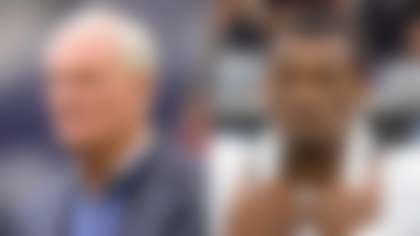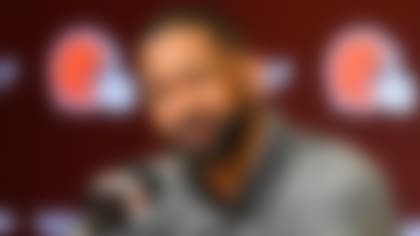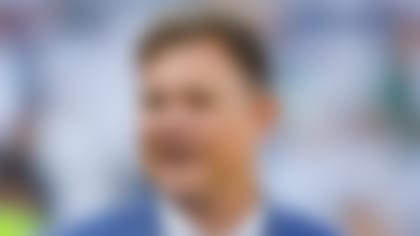SAN DIEGO -- Here are five topics from the San Diego Chargers' training camp worth a closer look:
1. Off-season couch potato
You wonder how placekicker Nate Kaeding, who had an outstanding season in 2007, can improve his game. Here's how: He spends part of the offseason at a facility in Indianapolis, where many NFL kickers spend part of their time working on their technique, and another part of it with a sports psychologist in San Diego.
"(At Indianapolis) I just kind of did a comprehensive look at my body and what areas I could strengthen," Kaeding said. "I picked up some new training drills."
Among them were variations of lifting weights with his legs that involved twisting his body and specific ways of positioning his feet. The sports psychologist with whom Kaeding hired also works with a number of professional golfers.
"As a kicker now, when you're kind of reaching the peak of your physical level, you really get to understand and appreciate the importance of a consistent mental approach and proper breathing techniques," he said.
Kaeding also put together a videotape highlight of successful kicks that he will watch during the week before a game to help reinforce positive thinking.
"Nothing too quirky," he said. "We're not sitting on couches talking through dreams or anything like that."
2. Gates will 'definitely be ready for opener'
Antonio Gates has no intention of allowing his surgically repaired left big toe to prevent him from being the dominant tight end he has been throughout his career with the Chargers. Gates isn't taking part in team drills, but he has been doing plenty of agility work and continues to be optimistic about his chances of being ready for the Chargers' Sept. 7 season opener against Carolina.
"I want to be as strong as possible when the opener hits," Gates said. "Sometimes you can have setbacks, but I'm just constantly working. Every day, it's just going out there trying to do more. I'll definitely be ready come the opener."
Gates makes a point of trying to push himself as far as he can each day. This week, his emphasis has been on pushing off as he would need to do to run routes. He feels pain and will back off as the pain increases. However, he knows, over the course of camp, he will be able to do more.
"One day I might be able to finish a workout and it won't get sore until the end of the workout," Gates said. "Then, the next day, it might get sore that night. Then it might not get sore until the next day, so as long as it's constantly progressing, I feel good about it."
3. Training for training camp
How has Philip Rivers been able to make dramatic progress in recovering from surgery to repair a torn right ACL? It's all in the training methods used by the Chargers' training staff during the offseason.
[Camp: San Diego
Preseason games:
Aug. 9:
Dallas, 7 p.m. ET
Aug. 16: at St. Louis, 8 p.m. ET
Aug. 25: Seattle, 8 p.m. ET
Aug. 29: at San Francisco, 7 p.m. ET
"We rehabbed it a little different than a normal ACL," Rivers said. "(Chargers trainer) James (Collins) wanted to approach it from the quarterback position and do a little more functional stuff that applied to my position, which allowed me to be less sore sooner and just do some things to help you fundamentally."
For instance, when Rivers did lateral work, he didn't merely perform an exercise. He held a football in his hand and moved as he would in the pocket.
"I was shuffling and backpedaling and doing all of that stuff that relates to my position," Rivers said. "Now, as I get out here in training camp, it's not like I'm doing it for the first time."
4. Playing it safe
Veteran nose tackle Jamal Williams, who is recovering from surgeries on both knees, has been kept out of team drills. Although Williams says he feels great and has looked good in individual work, the coaches are being extremely cautious with him. The last thing they want to do is cause Williams to suffer any sort of setback that could diminish his playing time in the regular season.
"He's the best nose tackle I've ever coached," defensive coordinator Ted Cottrell said. "And I've coached some good ones up in Buffalo, (such as five-time Pro Bowler) Freddy Smerlas and Pat Williams (now with Minnesota). But this guy is the best. He'll be there. From a mental standpoint, he's not worried. (His knees) are not a problem."
The Chargers want to keep it that way.
5. Signal strength
All NFL teams are experimenting with the new coach-to-player system of communicating defensive signals, which will be used for the first time this season. Originally, inside linebacker Stephen Cooper was going to be the Chargers' designated player to receive the signals through a receiver in his helmet. However, because he will miss the first four games of the season due to a suspension, the team has had to try it out with another inside linebacker, Matt Wilhelm.
"Dealing with it the last couple of days, the thing I've noticed about it is you're able to get your calls into the guys a couple of seconds quicker (than hand signals) and that gives them a couple seconds head start on what they're supposed to do," Cottrell said.
On third down, when offenses tend to do more late substitutions and therefore result in the system being automatically shut down with 10 seconds left on the 30-second clock, Cottrell reverts to using hand signals.
Have a question for Vic on anything NFL related? Don't just sit there -- send it to AskVic@nfl.com, and the best questions will be answered throughout the season right here on NFL.com.



